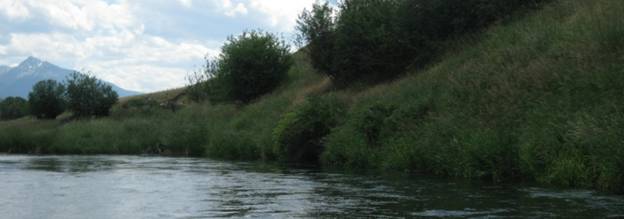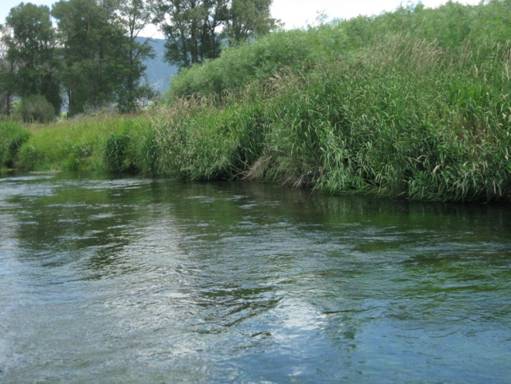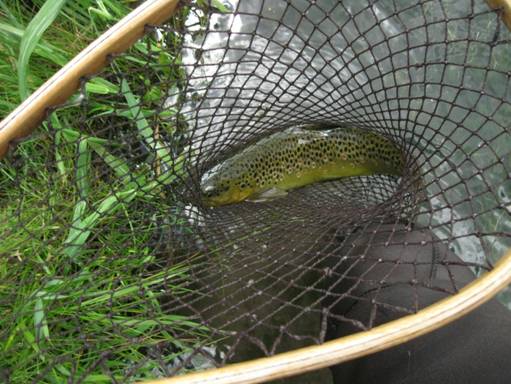NO FINESSE ANGLING

There are innumerable fly fishing article about the skill, attention to detail, delicacy, and precision casting necessary to be a successful fly flinger. One of the great things that happens during the ‘dog days’ of summer is the ability to spend a day fly fishing without all the fancy casting skills and hatch-matching skills that are the hallmark of much of what we call fly fishing. Although I enjoy the entire hatch-matching, fine tippet, precision casting fly fishing I must admit that I find a certain degree of satisfaction fly fishing without worrying about all those nuances, and I get that opportunity every year when terrestrial insects become a main feature on the menu of the trout that inhabit my local waters.
By late July the hatches of early summer have begun to fade on many streams. The vegetation along the banks has matured and many terrestrial insects are at the peak of their life cycles. Poke around in the vegetation along the edge of any body of water and you will find a plethora of insects; ants, caterpillars, beetles, grasshoppers, spiders, and a panoply of other creepy crawlers. These are no stream born insects and they don’t have any attachment to the water, however a gust of wind or an errant misstep often places these critters into the nearby water. Once on the water they are at the mercy of the currents and the resident fish population is very much aware of their presence.
Recently I finished up my morning household chores and since the Ladyfisher was otherwise occupied with something or other I fired up the old fishing vehicle and hit the water for a couple hours of fishing. The sky was clear and the air temperature was approaching the low 80’s by the time I arrived at the stream. Except for a few errant caddis flies and an occasional Pale Morning Dun there was no apparent insect activity. I could have worked the riffle areas with a pair of small nymphs or I could have stalked the flats looking for an occasional riser but I chose to bypass the more technical angling and simply pitch a terrestrial along a stretch of promising stream bank.
Terrestrial fishing is what I term as “no finesse angling.” Terrestrial insects don’t belong in or on the water, but as the summer progresses they become more and more prevalent in and on the water due to the increase growth of streamside vegetation that provides food and shelter for them. The wind rustles the grass, a critter or angler [really both the same thing] walks near the stream edge, or simple carelessness plunges them into the water. Unlike aquatic insects that belong in or on the water they tend to be less than pleased by this turn of events. They land in the water in a rather ungraceful fashion and squirm and struggle as they try to regain dry land. Unlike most aquatic insects they set in the film rather than on the film, and some will even sink. Given these characteristics it is quite easy to see why this is no finesse angling.
Since the naturals tend to fall in the water from the streamside vegetation most of the trout will be holding close to the bank to seize them as they fall in. To be successful your imitation should be as close to the bank as possible to cover the fish that are holding right along the vegetation line.
On my recent angling expedition I selected an old favorite terrestrial pattern – a Crowe beetle. Several years ago I tied up a number of these traditional beetle imitations – black deer hair pulled over the hook to form the shell back and a few hairs splayed out near the eye to imitate legs. I tied them in a variety of sizes and the one I choose on this day was a size 14. I was using a 3 weight rod and a 9 foot leader. I walked downstream a distance from where I parked my car and then fished my way back casting my imitation along the very edge of the vegetation.

Ideal terrestrial water
Since beetles are not aquatic insects [although there are aquatic beetles] they tend to land with a splat and I attempt to imitate this crash landing effect with my beetle imitation. When trying to set the beetle right next to the bank I would often drop the beetle in the grass and a tug will normally cause the beetle to pop out of the grass and land on the water – just like the real thing. However, sometimes you hook the vegetation and you will either have to wade over and retrieve you fly or tug on it and hope the leader holds. Even if you lose a few flies to the grass this is a good technique that allows you to get your fly as close to the bank as possible plus allowing your imitation to hit the water just like the real thing.
While I concentrate on putting my imitation as close to the bank as possible I do not neglect the rest of the stream since not all the trout will be holding right next to the bank. Although many terrestrials will enter the water close to the bank insects like grasshoppers will often hit the water far out from the bank. On windy days, especially when the winds are gusting, all manner of terrestrial insects may be found floating anywhere on the surface. Mating flights of terrestrial insects, like ants and termites, will often litter the surface like a major spinner fall. As I work my way along plopping my imitation next to the bank I also drop my imitation in other likely looking spots where I think a trout might be holding and looking for an easy meal.
As I fished my way back to my car I moved several fish, but the most interesting situation developed along a place where the grass had formed a tunnel over the water. The grass form a tunnel that was several feet long and right at the mouth of the tunnel I noticed a slight disturbance. As I watched a good fish swirled right at the mouth of tunnel and I surmised that it was holding right at the lip of the tunnel. This provided excellent protection from anything coming from above and the funneling affect of the grass trailing in the water provided a steady supply of food.
To get a fly to this fish was a tricky proposition. The grasses just above the tunnel entrance set off a series of errant currents and several long strands of grass hung just over where the trout was holding making it difficult to drop a fly directly into his feeding position. I believed that I would have just one shot at this particular fish so it had better be a good one.
I carefully measured out my line and made a few cast several feet above where the trout was holding to make certain that I had out sufficient line to allow me to make a slack line cast just above my target. I shot a cast right toward the bank and then, as the fly straighten above the grass, I gave the line a tug which caused the fly to stop quickly and bounce back. This allowed the fly to drop free of the grass but quite close to the bank with enough slack to permit it to float unhindered right into the mouth of the tunnel. Bingo, there was a nice swirl as the fish rose to my imitation and pop I pulled the fly right out of his mouth!
I fished for about an hour and a half leisurely dropping my beetle along the grass and I moved several fish during this time. Several of them were relatively small fish but a couple put a nice bend in my rod. Since there were not enough aquatic insects hatching to elicit any surface feeding fishing a terrestrial imitation allowed me to move some fish that I would not have been able to move any other way. In addition, it did not require much thought or angling expertise to pull it off, and that suited me just fine.

A nice brown trout that thought my beetle was the real thing.
